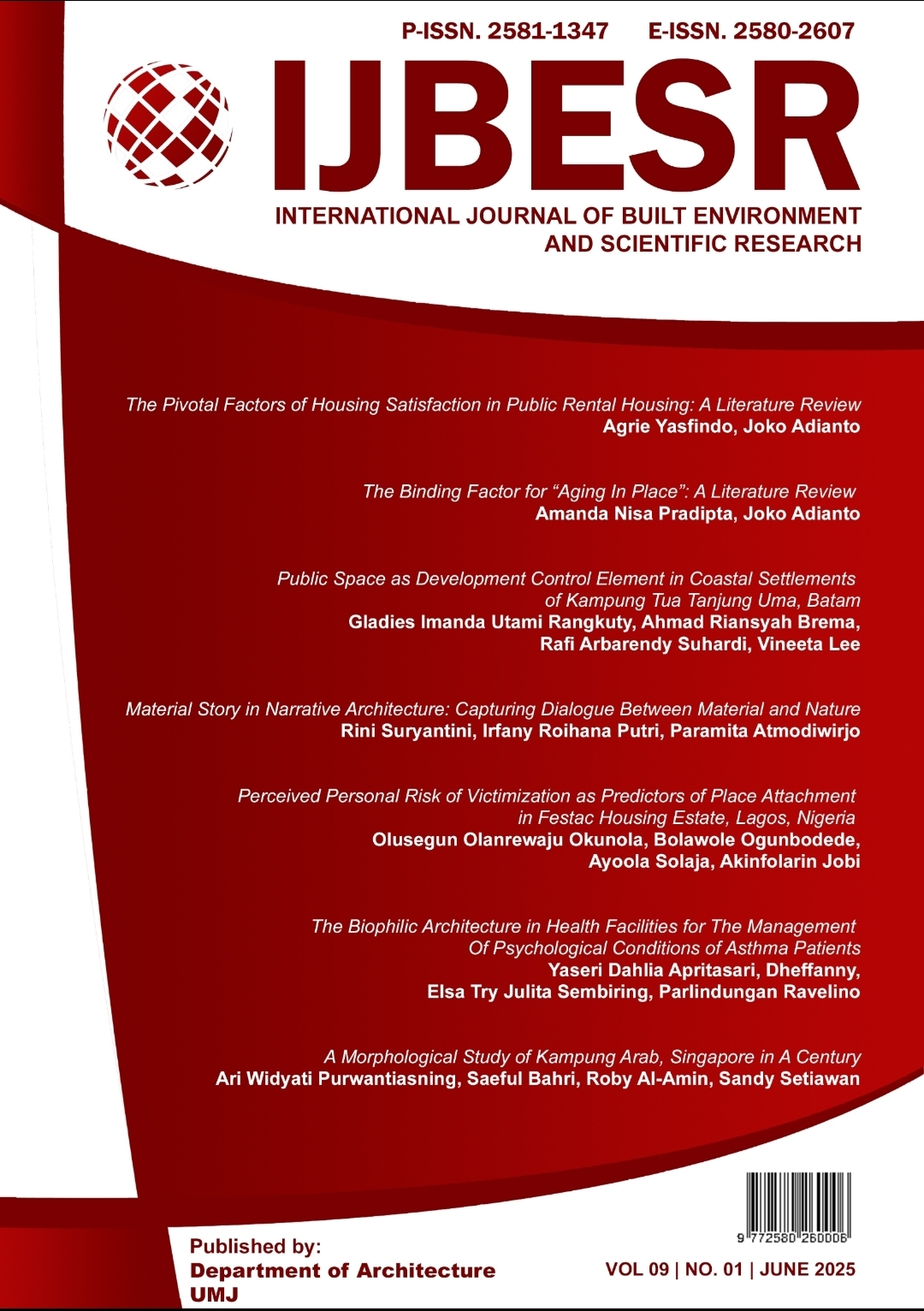Public Space as Development Control Element in Coastal Settlements of Kampung Tua Tanjung Uma, Batam
DOI:
https://doi.org/10.24853/ijbesr.9.1.23-32Keywords:
Public Space, Sustainable Development, Coastal Settlements, SustainabilityAbstract
Public space is a crucial element in urban design, especially in coastal settlements, because it acts as a main factor in controlling development and creating a balance between land development and the social needs of the community. Rapid urbanization in Batam causes environmental degradation and unplanned changes in land use, limiting public access to public spaces. This research aims to identify and analyze how public space can be used effectively as an instrument to control sustainable development in Tanjung Uma. This research uses descriptive qualitative methods to analyze the role of public space in managing city growth and maintaining socio-economic balance and environmental sustainability in Kampung Tua Tanjung Uma, Batam. The research results show that the main challenges are limited accessibility, decreased environmental quality, and minimal public space facilities. Strategies for revitalizing public spaces, increasing accessibility and optimizing spatial planning are proposed to support sustainable development and improve community welfare, by involving local communities in managing public spaces.References
Yistiarani, W. D (2020). Kehidupan Masyarakat Pesisir di Indonesia. BALAIRUNG: Jurnal Multidisipliner Mahasiswa Indonesia, 7-12.
Batam News Asia. (2024, 24 September). Regional and local impact at Batam for UN’s global pact for the future. Batam News Asia. Diakses dari https://batamnewsasia.com/2024/09/24/regional-and-local-impact-at-batam-for-uns-global-pact-for-the-future/
Iskandar, D. J. (2019). Dimensi krusial ruang publik dalam proses perumusan kebijakan yang bermakna untuk kebaikan bersama. Jurnal Ilmu Administrasi: Media Pengembangan Ilmu dan Praktek Administrasi, 12(1), 1–16.
Zubaidi, F. (2009). Ruang dan teritorialitas pada kawasan ruang publik pesisir Teluk Palu. Jurnal Researcheran Sains dan Teknologi, 10(2), 88–96.
Noviantoro, K. M., Widjaja, H. R., & Ridwan, M. (2022). Penataan ruang wilayah pesisir sebagai upaya mitigasi bencana tsunami di Pantai Watu Pecak, Kabupaten Lumajang. Jurnal Wilayah dan Lingkungan, 10(3), 189–200. Retrieved from ejournal2.undip.ac.id
Carmona, M. (2015). Public space design and management. Journal of Urban Design, 20(5), 620-631. https://doi.org/10.1080/13574809.2015.1071652
Carr, S., Francis, M., Rivlin, L. G., & Stone, A. M. (1992). Needs in public space. In M. Carmona, & S. Tiesdell (Eds.), Urban Design Reader (pp. 230-240). Oxford, UK: Architectural Press.
Amback, B. C., Magalhães, P. M. C. d., Saraiva, L. E. S., de Sousa, M. M., & Miguez, M. G. (2025). Assessing Drainage Infrastructure in Coastal Lowlands: Challenges, Design Choices, and Environmental and Urban Impacts. Infrastructures, 10(5), 103.
Brundtland, G. H. (Ed.). (1987). Our common future: Report of the World Commission on Environment and Development. Oxford University Press.
Nur, M. S., & Husen, A. (2022). Studi Literatur: Penerapan Good Environmental Governance dan Pembangunan Berkelanjutan sebagai Upaya Pemberdayaan Masyarakat. Jurnal Green Growth dan Manajemen Lingkungan, 11(1), 35–49.
Sakai, T., & Arakawa, R. (2017). Conservation and development in coastal urbanization. Marine Policy, 82, 58-67. https://doi.org/10.1016/j.marpol.2017.05.005
Marasabessy, F., Laming, S., & Rahim, M. (2023). Impact of Waterfront City Development on Coastal Environmental Change and Local Wisdom in an Archipelago City. (ISCOMAR), 2 (1), 263–272.
Suwarno, A., & Abdullah, T. (2022). Kebijakan pengelolaan wilayah pesisir untuk pembangunan berkelanjutan di Indonesia. Jurnal Pengelolaan Pesisir dan Laut, 11(1), 15-27.
Hartanti, N. B., Prabowo, A. H., Fadhilah, A., & Rosnarti, D. (2019). Public space as development control element in coastal settlements: Comparison of urban design guidelines concepts. International Journal of Scientific & Technology Research, 8(10), 3417-3422.
Massera, N., & Wilkis, A. (2018). Spatial dynamics in coastal settlements and the role of public spaces. Environment and Urbanization, 30(2), 503-522. https://doi.org/10.1177/0956247818795346
Botutihe, A. H., Hambali, V. A. L., Masiga, N. I. D., Saleh, W. A., & Syukri, M. R. (2023). Analisis karakteristik permukiman di wilayah pesisir. Jambura Journal of Urban and Regional Planning, 1(2), 24-30. https://doi.org/10.12345/jjurp.2023.020
Diposaptono, S., et al. (2009). Strategi Pengelolaan Wilayah Pesisir dan Pulau-Pulau Kecil Menghadapi Perubahan Iklim. Kementerian Kelautan dan Perikanan.
Jonsson, A., & Heldt Cassel, S. (2021). The social and environmental implications of public spaces in coastal communities. Coastal Management, 49(1), 45-62. https://doi.org/10.1080/08920753.2020.1857375
Dahuri, R., & Yulianto, E. (1996). Pengelolaan kawasan pesisir: Konsep dan implementasi. Dalam Pengelolaan Sumber Daya Pesisir (hal. 1-12). Universitas Terbuka.
Nasution, S. (2003). Metode Penelitian Naturalistik Kualitatif (Bandung). Tarsito. Library. Fis. Uny. Ac. Id/Opac/Index. Php.







